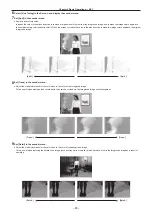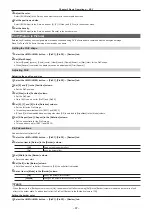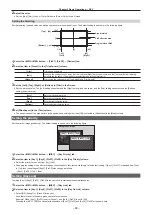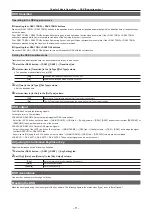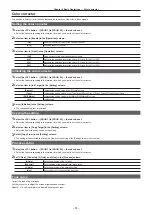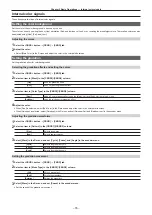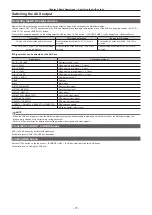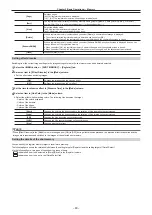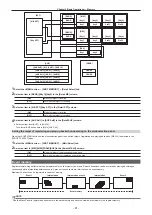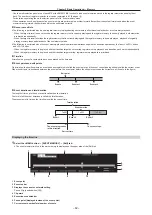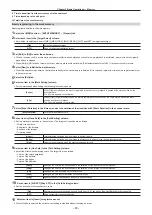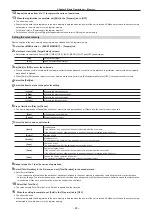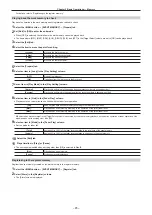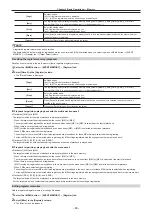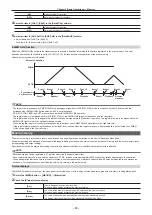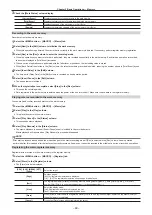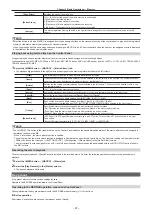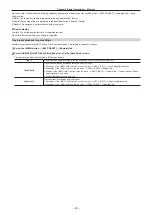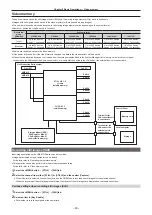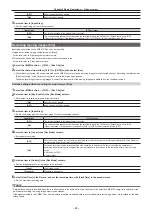
– 79 –
Chapter 5 Basic Operations — Memory
[CBGD], [XPT]
[CBGD]: Set to [On] to make the color background setting information the target of playing back.
[XPT]: Set to [On] to make the crosspoint information the target of playing back.
[Page]
Switches pages.
[ALL]: All registered memories are displayed.
[1-X] - [9-X]: The registered memories on each page are displayed.
[Sort]
The registered memory display is sorted by memory name ([Name
+
]/[Name
−
]), date ([Date
+
]/[Date
−
]), or memory
number ([No
+
]/[No
−
]), in either ascending order (
+
) or descending order (
−
).
[View]
Select the display mode.
[List]: Registered memories are displayed in a list.
[Icon]: Registered memories are displayed as icons.
[Recall]
Closes the [Recall] screen after recalling the target.
[Cancel]
Closes the [Recall] screen without recalling the target.
r
Resource conflicts
f
The following is performed when a new register memory is recalled during shot memory effect dissolve playback or event memory playback.
- When the target to recall does not overlap between the register memory that is currently playing and the register memory to be newly recalled, both
memories are played independently.
- When the target to recall overlaps between the register memory that is currently playing and the register memory to be newly recalled, playback of
the originally playing memory stops and playback of the new memory starts.
f
The following is performed when the shot memory effect dissolve playback is performed simultaneously with the transition operation by the fader,
<AUTO> button, and <CUT> button.
- When the recall target of the register memory to be played and the transition target do not overlap, register memory playback and transition each
works independently.
- When the recall target of the register memory to be played and the transition target overlap, register memory playback is prioritized.
r
Playback target (when playing back with the multi-selection panel)
f
Playback of [ME1] and [ME2]
The target selected at the start of playback is always played back.
- When the target selected at registration is either one of [ME1] or [ME2]
The target selected at registration is played back even when either [ME1] or [ME2] is selected at the start of playback.
- When there is no target selected at registration
[ME1] recorded at registration is played back even when either [ME1] or [ME2] is selected at the start of playback.
- When 2 MEs were selected when registering
The settings for the relevant ME when it was registered are played back for those MEs that were selected when registering.
For those MEs that were not selected when registering, the ME settings registered with the youngest numbers are played back.
f
Playback of [DSK], [AUX], and [CBGD]
The target selected by both operations at registration and the start of playback is played back.
r
Playback target (when playing back with the menu panel)
f
Playback of [ME1] and [ME2]
The target selected at the start of playback is always played back.
- When the target selected at registration is either one of [ME1] or [ME2]
The target selected at registration is played back even when either [ME1] or [ME2] is selected at the start of playback.
- When there is no target selected at registration
[ME1] recorded at registration is played back even when either [ME1] or [ME2] is selected at the start of playback.
- When 2 MEs were selected when registering
The settings for the relevant ME when it was registered are played back for those MEs that were selected when registering.
For those MEs that were not selected when registering, the ME settings registered with the youngest numbers are played back.
f
Playback of [DSK], [AUX], and [CBGD]
The target selected at the start of playback is always played back.
For the target which is not selected at registration, playback is performed with the setting at registration.
Editing register memories of the shot memory
Delete a registered register memory or change file names.
1
Select the <MEM> button
→
[SHOT MEMORY]
→
[Register] tab.
2
Select [Misc] in the [Register] column.
f
The [Misc] screen is displayed.
Содержание Live Production Suite Series
Страница 5: ...Please read this chapter and check the accessories before use Chapter 1 Overview ...
Страница 11: ...This chapter describes installation and connection Chapter 2 Installation and Connection ...
Страница 33: ...This chapter describes basic operations and matters to be performed prior to use Chapter 4 Preparations ...
Страница 50: ...This chapter describes menu operations Chapter 5 Basic Operations ...
Страница 107: ...This chapter describes the input output signal settings Chapter 6 Input Output Signal Settings ...
Страница 112: ... 112 Chapter 6 Input Output Signal Settings Setting MultiView displays f f Set the marker size ...
Страница 113: ...This chapter describes the configuration of operations Chapter 7 Configuring Operations ...
Страница 122: ...This chapter describes how to operate system menus Chapter 8 System Menu ...
Страница 136: ...This chapter describes plug in functions Chapter 9 External Interfaces ...
Страница 138: ...This chapter describes the dimensions and specifications of this product Chapter 10 Specifications ...
Страница 139: ... 139 Chapter 10 Specifications Dimensions Dimensions Dimensions of the Gateway Unit AV LSG10 Unit mm inch ...
Страница 140: ... 140 Chapter 10 Specifications Dimensions Dimensions of the XPT Unit AV LSX10 Unit mm inch ...
Страница 141: ... 141 Chapter 10 Specifications Dimensions Dimensions of the ME Unit AV LSM10 Unit mm inch ...
Страница 142: ... 142 Chapter 10 Specifications Dimensions Dimensions of the System Manager Unit AV LSS10 Unit mm inch ...
Страница 153: ...This chapter describes the setting menu table and terms Chapter 11 Appendix ...
Страница 176: ...Web Site https www panasonic com Panasonic Corporation 2020 ...

